When my quilty gifts move outside the "inner circle" -- my family and my absolute closest friends -- I feel a bit nervous. I don't think it's necessary, since just about everyone for whom I have made a quilt has seemed to be appreciative. But it still feels like an outing...not in the sense of a picnic or trip to the beach, but in the sense of having the fabric cupboard doors flung open. I'm out; yes, I quilt!
I based this quilt on the "Irish Chain" pattern in Denyse Schmidt's beautiful new book Modern Quilts, Traditional Inspiration and first shared the project a couple of weeks ago. Schmidt's version of Irish Chain uses 3/4" squares...yes, that's 3/4", very small, with lots of negative space. I drew from my stash, using the reverse side of a mocha textured solid from Connecting Threads (the texture pattern shows through just ever so slightly) for the background and Yuwa Live Life letters (a soft parchment colour) for the majority of the squares in each chain. I threw in a few odd squares for interest -- arithmetic fabric, a McCall's dress pattern print, some Lecien Minny Miu puppets, and some aqua V & A "Grand Tour" Venice.
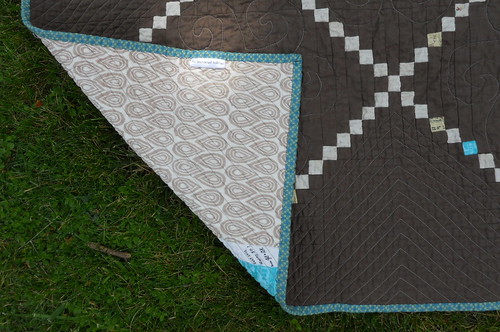
For the back of the quilt I used some Prints Charming teardrops (official name of the print is long forgotten, I apologize) and a strip of the aqua Venice print. Wanting to play up the Mediterranean slant, I attempted to free motion quilt sea creatures in each of the 13 diamonds formed by the intersecting chains.
I have to admit that I'm not terribly pleased with my FMQ...I'm rusty, there were a wagonload of seams of travel over, and I didn't take as much time with the quilting as I should have. Hrumph. Fortunately my flickr pals talked me off the ledge, just as I was leaning towards a complete unpick and redo. In retrospect, the quilting is just fine -- and it certainly didn't diminish the pleasure my friend seemed to take in this gift!
One product I used for the first time in the making of this quilt is Heat Press Batting Together fusible tape.
I have only been quilting for a couple of years, but I have already accumulated a huge amount of cotton and some wool batting scraps, and none was large enough for this quilt. (These scraps are actually becoming a problem for me: I really don't make many small projects...but if you do, and if you're in the Toronto area, you're welcome to a big bag of scraps! Send me a message!).
In the past I have patched together pieces of batting using a whip stitch, but a fusible alternative was very appealing, so I bought a roll of this (it was under $4) in a Connecting Threads order many months ago.
This stuff is just as you might expect -- a roll of very flexible woven fusible.
Pretty straight forward, you line up the edges of two pieces of batting (I was using scraps of Hobbs Heirloom Natural Cotton both in this quilt project and here in the dramatic recreation of events). You place the gritty, glue side of the fusible tape down and press with an iron as you would a fusible interfacing.
The problem I ran into (and which was easily recreated here) is that it is tricky to keep the edges of the batting scraps tightly aligned; they tend to shift a little bit in the pressing, nothing significant but it is annoying. And because this fusible tape is so flexible there is a lot of play.
I really didn't like the gap that formed between the pieces. In fact, at one point when I was joining two very large pieces and trying to move them around the ironing board, some of the fused tape started to pull off the batting -- still glued to a bunch of cotton fibers, but not doing its job.
EDITED TO ADD: Sue kindly pointed me to a youtube tutorial posted by Jeanne Harwood herself (inventor of this tape). From watching this, it looks to me like one key to avoiding this gap is to use the iron for heat but not pressure. DON'T PRESS HARD! I'm going to give that a try next time and will report on the results.

I ended up whipstitching right through the tape, something like this --
and in fact the tape gave a nice reinforcement to the stitches. So I would say that -- for me, based only on this first attempt -- this product works, but not perfectly. I'm not sure I would be comfortable relying on it alone for joining scraps of batting, but I'm definitely going to give it another try -- avoiding pressure with the iron next time around. Jeanne Harwood's video has inspired me to give this tape another go!

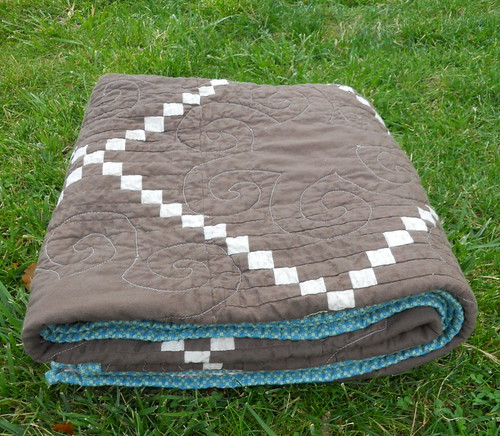
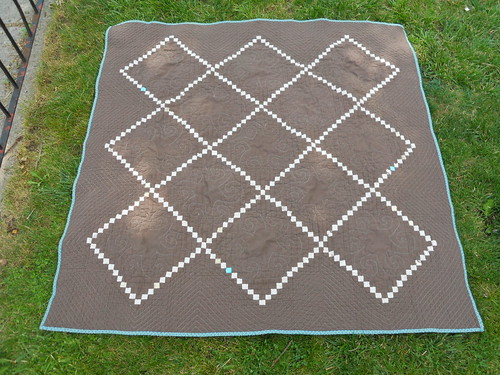

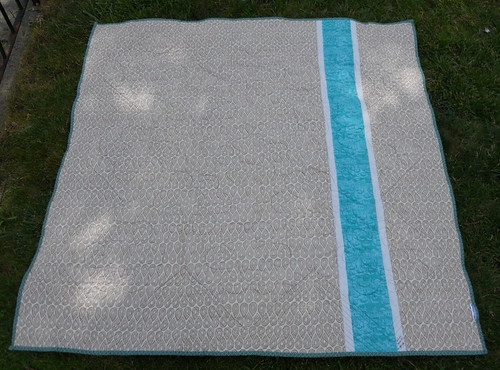
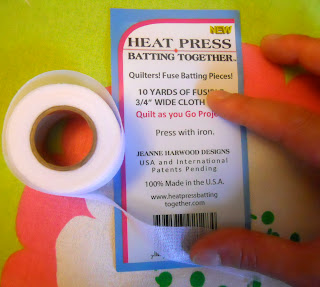




5 comments:
It's a lovely quilt. Classic in it's simplicity. I'm not surprised your friend liked it
What a lovely gift for your friend. I have the same batting tape and I found this tutorial helpful. http://www.youtube.com/watch?v=UWyfk7XBG3I&feature=related It is by the woman who invented the tape. I looked at a few and this one was the most useful.
Thanks so much for that link, Sue! It sounds like the key issue is pressure on the iron -- or rather NOT to apply pressure with the iron! I'll add a note to the post/review and give that a try next time.
I always join my batting scraps on the machine. Make sure both edges are straight to avoid bumps, use your walking foot and use a stitch that goes left and right and make it as wide as possible. The one I use is called a faggoting stitch (now, now!) It works brilliantly and saves waste. A wide zigzag would also work.
I love this quilt - it's wonderful in it's simplicity. Irish chain is one of the patterns on my "list" of to-dos.
I join my batting pieces with a zigzag stitch. Before joining, I try to make sure the pieces go the same way (one way stretches more than the other, similar to grain in fabrics). Probably not crucial but I learned this tip in a class. Helps the quilt to hang without ripples.
I use my random scraps to practice my FMQ.
Post a Comment